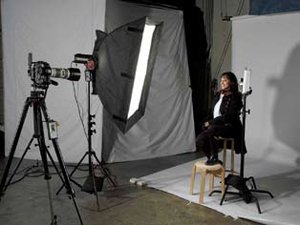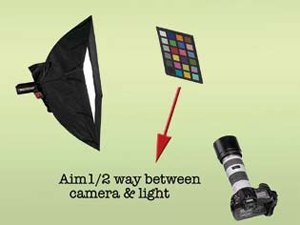articles/Lighting/lightingfordigital1-page2
Lighting for digital 1 - part 2 of 1 2 3
by Dave Montizambert Published 01/01/2009

Finding the best exposure in the resulting images from this 'Shirley' test allows one to find the true ISO or sensitivity of their film or camera's image sensor. Now you may well find that the sensitivity or ISO settings on your digital SLR camera are spot on, most are, so why bother? You should bother because in addition to checking to see if your camera ISO settings are accurate, you will be able to match your handheld meter with your camera and you will get a correctly exposed raw file from this Shirley test.
This correctly exposed image is required to determine your optimum processing settings. Once these optimum settings are figured out, you save them as a preset, that saved preset is your default processing algorithm - now that you know how your images will be processed you can light to that standard, thus solving the 'chicken or egg' quandary.

My Shirley or sensitivity test consists of photographing a greyscale and a recognisable flesh-tone (see Image 01) - I like to use my wife Sylvianne since I am very good at recognising her flesh. The greyscale I use is a 24 patch Macbeth Color Checker. Since these are fairly expensive (£42.50 ex VAT www. colourconfience.com - Ed.), you could get away with using the Kodak Separation Guide 21 density greyscale but the Macbeth card is manufactured to a tighter tolerance level.
For a white point instead of using the white swatch on the Macbeth card or Kodak scale, I like to use a three-dimensional white point. My three-dimensional white-point is a simple inexpensive idea that a colleague of mine thought up. It is a small, rolled piece of clean, white, seamless paper. The idea of a rolled, white, semi-matte surface is that instead of it being flat like the grey scale white swatch, it has a rounded surface; that rounded surface at some point will pick up a little specularity, or in lay-person's terminology, glare, from the main source of illumination.
That specularity or glare is going to mix with the paper, brightening its whitepoint. This gives us more of a 'real-life' white point. A white wedding dress is a perfect example of this; certain areas of that dress that are on the correct angle to the light 2 source relative to camera viewing angle, will catch some specularity. Since this is not a true catch-light, most photographers would like to hold some detail in these hot areas and so set this white-point to the brightest possible value in the image capture without letting it burn-out (clip).
Please Note:
There is more than one page for this Article.
You are currently on page 2 Contact Dave Montizambert
1st Published 01/01/2009
last update 09/12/2022 14:55:47
More Lighting Articles
There are 0 days to get ready for The Society of Photographers Convention and Trade Show at The Novotel London West, Hammersmith ...
which starts on Wednesday 15th January 2025





